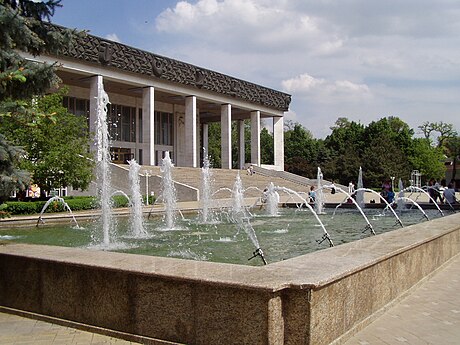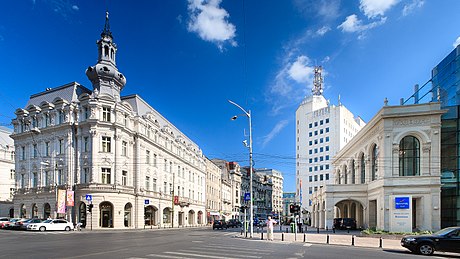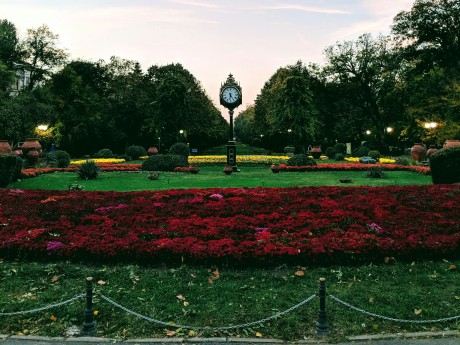Moldova & Romania: Chișinău and Bucharest
Embark on a journey to Eastern Europe, exploring the hidden gems of Moldova and Romania. Start in the charming city, Chisinau, with its historic landmarks, vibrant parks, and burgeoning nightlife. Wine enthusiasts can indulge in a journey through picturesque vineyards, sampling local varieties and learning about the age-old winemaking techniques in the vast underground cellars of Milestii Mici or Cricova.
Read more
Embark on a journey to Eastern Europe, exploring the hidden gems of Moldova and Romania. Start in the charming city, Chisinau, with its historic landmarks, vibrant parks, and burgeoning nightlife. Wine enthusiasts can indulge in a journey through picturesque vineyards, sampling local varieties and learning about the age-old winemaking techniques in the vast underground cellars of Milestii Mici or Cricova. Next venture into Romania's vibrant capital, Bucharest, known as the "Paris of the East." Be amazed at the Palace of Parliament, the world's heaviest building, and stroll through the historic Village Museum to witness traditional Romanian architecture. Indulge in the lively atmosphere of the Lipscani District, offering a mix of trendy cafes and historical sites. Both destinations promise a tapestry of experiences, making this Eastern European voyage a delightful blend of history, culture, and unforgettable moments. Waterviews strives to offer accommodation options within walking distance of water and/or in an area of touristic interest. Our prices include taxes (but excludes local tourist taxes). Customize your trip to your personal preferences with optional activities (hit the “Add Activities’’) or change hotels, etc. Contact us for customization at no extra cost at: Service@waterviewstravel.com
Destinations
- Chișinău
- Bucharest
Itinerary
Chișinău

Chişinău (Russian Kishinyov, Ukrainian Kishiniv, pronounced "Kishinau" with "nau" as in the English word "know") is the capital of Moldova with a population of around 790,000 plus 250,000 people coming each day for work and entertainment from all over the country and abroad. The city's territory with nearest suburbs cover the area of 635 km2.
Read more
Chişinău (Russian Kishinyov, Ukrainian Kishiniv, pronounced "Kishinau" with "nau" as in the English word "know") is the capital of Moldova with a population of around 790,000 plus 250,000 people coming each day for work and entertainment from all over the country and abroad. The city's territory with nearest suburbs cover the area of 635 km2.
Additional Information
Chişinău is very wealthy compared to the rest of the country, as Moldova is not a very rich country, and the countryside especially is poor. As is common in developing countries, you are likely to see great disparities in wealth. It's also very much a post-Soviet city, with both the good and bad qualities associated with it. By other side you'll see many modern and great buildings of steel, concrete and glass.
The majority of the middle and working class population lives in blocks of flats. These look standard, maybe not too nice but are not "dangerous" as similar areas may be considered to be in Western Europe. Do not expect Western standards everywhere, but the situation is improving every year. There are 4- and 5-star hotels, good restaurants and cafes, coffee houses and bars. Many restaurants and almost all the hotels in the city accept the credit cards. There are hundreds of ATMs throughout the city.
© Sourced from Wikivoyage
Bucharest

Bucharest (Romanian: București) is Romania's capital and largest city, as well as the most important industrial and commercial center of the country. With more than 2.1 million inhabitants in the urban area, Bucharest is one of the largest cities in Southeastern Europe.
Read more
Bucharest (Romanian: București) is Romania's capital and largest city, as well as the most important industrial and commercial center of the country. With more than 2.1 million inhabitants in the urban area, Bucharest is one of the largest cities in Southeastern Europe.
Additional Information
Bucharest is the primary entry point into Romania. Bucharest is a booming city with many large infrastructure projects changing the old face of the city. Known in the past as "The Little Paris," Bucharest has changed a lot lately, and today it has become a very interesting mix of old and new that has little to do with its former reputation. Finding a 300-year-old church near a steel-and-glass tower that both sit next to a communist-style building is commonplace in Bucharest. Bucharest offers some excellent attractions, and has cultivated a sophisticated, trendy, and modern sensibility that many have come to expect from a European capital. Bucharest has benefited from an economic boom along with the EU grants that have helped rebuild parts of the city, including the revamped old town. Those who have known Bucharest in the past but have not visited recently will be surprised by the changes that are taking place. The largest finished project is the impressive Basarab overpass, which is Europe's widest cable bridge.
Language
The official language is Romanian, a Romance language which claims to be the closest currently-spoken relative to Ancient Latin, but contains around 20% of loan words from Slavonic languages. Most younger educated people will speak English reasonably well and will likely be proficient in one or more second Romance languages; most educated people born before about 1970 will speak French, Spanish or Italian reasonably well. The Roma people (Gypsies) speak their native Romany, as well as Romanian, and sometimes English as well. Beyond that, as in any major city, there will be a smattering of other languages like Chinese, Arabic, Turkish, Hungarian and German.
Climate
Bucharest, like most of Romania, has a temperate-continental climate with hot summers and cold winters. This region of Romania gets all four seasons, although spring is brief and falls mainly in April. The average high daily temperature in summer is about 29°C and in winter about 2°C. It can get really hot and dry during the summer (30°C) and really cold during the winter (-20°C), even though temperatures below -12°C are extremely rare. Best time to visit is April through June, September through October and early December.
Time
Bucharest is in the Eastern European time zone (UTC+2, with a DST of UTC+3 from April to October).
© Sourced from Wikivoyage





